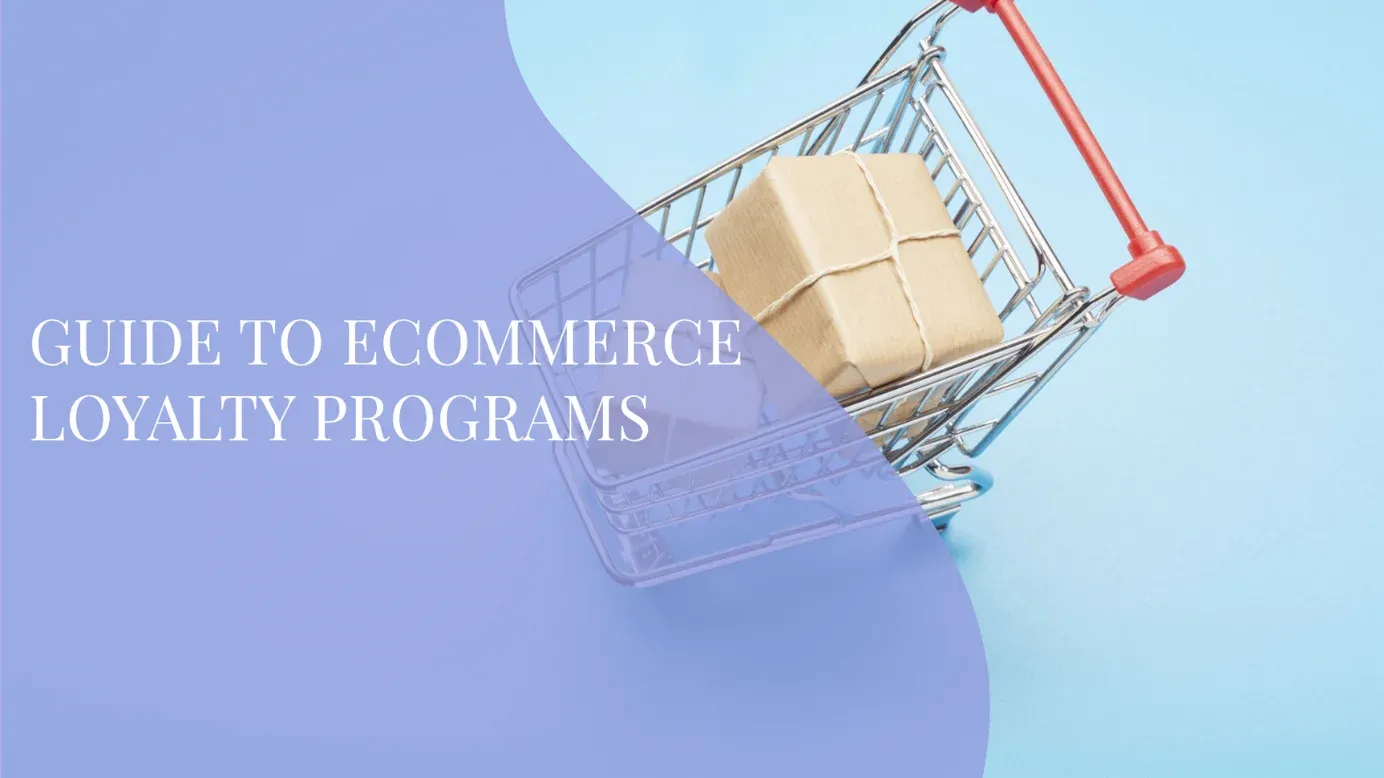E-Commerce Loyalty Programs: The Guide Boost Retention and Customer Engagement
eCommerce loyalty programs are game-changers for strengthening customer relationships and driving business growth. These programs offer tailored rewards, enhance customer retention, and foster brand loyalty by creating meaningful connections.
On this page
Online shopping is important, and companies want you to continue making purchases. That is where loyalty programs come in handy. These programs reward you for shopping within the same brand frequently. They are a means of extending gratitude and ensuring that you remain cheerful.
In fact, the top-performing loyalty programs boost revenue from customers who use them by 15-25% annually.
Here, we will discuss loyalty programs, why eCommerce stores need them, and what makes a good loyalty program. We will also guide you through the process of creating your loyalty program from scratch and provide you with examples of successful programs so that you can be inspired.
No matter if you are starting a loyalty program from scratch or looking to improve your existing one, this guide covers all the basics for constructing a loyalty program that will engage your customers and grow your online business.
What are the eCommerce loyalty programs?
An eCommerce loyalty program is a rewards system that online businesses use to encourage repeat purchases. These programs offer rewards like discounts, special content, and early product access, meeting shoppers' diverse interests. When customers enjoy these benefits, businesses see increased loyalty and sales.
These programs are designed to be a seamless part of the shopping experience, building a strong community around your brand. They can be simple, like earning points for rewards, or more complex, with features like games and achievements. The key is to make the program easy to understand and enjoyable for customers.
Why loyalty programs matter for eCommerce businesses
Loyalty programs are essential for eCommerce businesses aiming to retain customers in a competitive market. They not only encourage repeat purchases but also foster stronger relationships by rewarding customers for their trust and engagement.
- Strong connection with the brand: Collecting loyalty points makes a customer feel more involved with the brand; they are now an insider in a certain sense. This makes them interested in coming back for more and recommending them to friends about the brand.
- Promoting new products: These programs allow organizations to inform consumers about new products before the general public is made aware of them. Customers in the program may be likely to be experimental in their buying decision-making, which is an added advantage to the business since the business will be able to sell more and get feedback from its customers.
- Making more money: Some benefits of loyalty programs include the following: By encouraging more frequent customer purchases, more money can be made for the business. If they know that they stand to get certain rewards or have an opportunity to get certain types of discounts, they may find it convenient to shop more often.
- Getting useful information: Businesses can discover a lot from such programs regarding the customer profile, such as their preferred products and their frequency of purchase. This information can also assist businesses in making correct decisions about what products to provide and how to position those to the customers.
- Selling more: With special discount coupons and reward offers, companies can sell more products to customers and earn greater revenues per customer. This may help customers be willing to purchase several products at once or select items that are slightly more costly than they would if they spearheaded a campaign that would award them some points or other alternative incentives.
- Keeping customers coming back: Customer loyalty can be attained by offering them more reasons to shop in those stores and not elsewhere. If they are told that they will get some reward or they will get some discounts, then they may prefer to shop in that store than go somewhere else.
Challenges in eCommerce customer retention and solutions with loyalty rewards
Customer retention remains a critical hurdle for eCommerce businesses. Loyalty rewards offer a strategic way to tackle these challenges, fostering engagement and long-term connections.
1. Price sensitivity among shoppers
Customers frequently compare prices across platforms, gravitating toward the cheapest option. This creates a transactional mindset, leaving little room for brand loyalty.
How Loyalty Rewards Help: Loyalty programs can shift the focus from price to value by offering points, cashback, or exclusive discounts. For example, providing double points during sales or cashback for specific purchases incentivizes customers to stay with your brand, even if prices are slightly higher.
2. Lack of personalization
Customers now expect tailored shopping experiences. Generic marketing or rewards fail to engage, leaving customers feeling undervalued.
How Loyalty Rewards Help: Advanced loyalty platforms use customer data to offer personalized rewards, such as birthday discounts, curated product recommendations, or exclusive deals based on purchase history. For example, a beauty retailer could offer loyalty members discounts on skincare if their past purchases show a preference for such products.
3. High cart abandonment rates
Cart abandonment is a major challenge, with studies showing that over 70% of online shopping carts are left unpurchased.
How Loyalty Rewards Help: Offering loyalty points or free shipping for completing purchases can encourage customers to proceed to checkout. For instance, sending an email with “Earn 500 bonus points if you complete your purchase within 24 hours” can prompt action.
4. Low repeat purchase rates
Many eCommerce customers make a single purchase and never return, limiting their lifetime value.
How Loyalty Rewards Help: Welcome bonuses or first-purchase rewards encourage new customers to return. For example, a fashion brand could offer a discount code for a second purchase, sent immediately after the first transaction, to keep the customer engaged.
5. Difficulty in retaining long-term customers
Loyal customers often feel underappreciated if rewards programs don’t evolve with their increasing engagement.
How Loyalty Rewards help: Tiered loyalty programs address this by rewarding higher engagement with exclusive perks like early access to sales, VIP customer service, or higher point earning rates. For example, Amazon Prime’s subscription-based model offers free shipping and exclusive access to Prime Day deals, retaining high-value customers.
6. Low engagement between purchases
Customers often disengage if there’s no incentive to stay connected outside of transactions.
How Loyalty Rewards Help: Interactive features like gamified challenges, point multipliers for social sharing, or limited-time bonus offers keep customers engaged. For instance, an eCommerce store could offer double points for reviewing products or sharing purchases on social media.
Essential components of an effective loyalty program
An effective loyalty program is built on key components that drive engagement, foster customer satisfaction, and deliver measurable results. These elements ensure the program not only meets business goals but also creates meaningful value for customers.
1. Clear and straightforward rules
Ensure the rules are easy to follow. Customers should quickly understand how to earn points and redeem rewards without any confusion. If the rules are simple, more people will join and stay active in the program. Clear instructions can also reduce customer questions and make it easier for staff to explain the program.
2. Seamless integration with eCommerce
Your loyalty program should blend smoothly with your online store. Customers should be able to track their points and rewards while shopping online effortlessly. If they can see their points adding up and easily find out what rewards they can get, they will feel more motivated to keep shopping with you. Make it easy for them to use their points at checkout, too.
3. Optimized for mobile devices
Since many consumers rely on their mobile phones often, ensure that the program created is mobile-based. : It should be highly responsive especially when used on handheld devices like the Smartphone and Tablets.
If they frequently use their mobiles, they are quite conscious about their points and rewards using the program. Specifying that the mobile version should not be complicated and be as friendly and usable as the desktop version.
4. Multi-channel engagement
Market the product to customers through electronic means such as emails or physical touchpoints such as the in-store experience. This helps to maintain their bond and keep them informed of why your program may be best suited to their needs. You ought to remind them of the points and rewards they have through other methods so they may not forget. Encourage your customer to survey social media or through emails, thereby offering more points or a special offer.
5. Effective offline presentation
To achieve penetration, communicate your loyalty program through physical shops. Promote membership through other alternative methods, such as the use of signs, membership brochures, and product recommendations by members of staff.
Ensure that the signing-up processes are as simple as possible and that employees will be well capable of walking customers through the positive experiences. Since the notices are not always easily noticeable, having the program aired and being displayed in the store might catch the attention of those who did not know of its existence.
6. Personalized experience
Try to integrate some personal elements into your program. Include messages such as ‘happy birthday’ or congratulations when sending automated emails and recommending products for repurchase. If the customers feel like the program is designed and implemented for them, they will stick around. The messages also affirm their worth as people, not merely as consumers, prompting a positive response from recipients.
How to create an eCommerce loyalty program
Creating an ecommerce loyalty program is a great way to keep your customers coming back. Here’s a simple guide to help you get started:
1. Set your goals
Think about what you want to achieve with your loyalty program. Do you want more repeat customers, higher sales, or better customer engagement? Clear goals will help you design your program. Knowing your goals will also help you measure your program's success and make any necessary adjustments.
2. Know your customers
Look at your customer data to understand what they like, how they shop, and what motivates them. This will help you create a program that they’ll love. Talk to your customers or send out surveys to get more insights. The better you know your customers, the more tailored and effective your loyalty program will be.
3. Pick the right program type
It is preferable to opt for the type of loyalty program that is best suited to both your company and your consumers. The most common ones are the point’s based programs, tiered-based programs, and subscription-based programs.
Both the questions posed were thought-provoking and would make you think about what your customers would like and the incentives they would be willing to respond to. The right type of program means they’ll remain engaged and interested in the consequent learning process.
4. Choose rewards
Select a type of loyalty program that is right for your business and that your customers will go for. These include the point-reward, tiered reward, and subscription-based programs. Consider the likelihood of the customers enjoying the content or seeing their participation as a motivation. The right type of program will keep them engaged with a lot of enthusiasm to enjoy the device.
5. Make It easy to use
Establish a straightforward working system so that the customer can easily decipher it. This could be a separate page on your website or a mobile application. Make it simple for them to track point accumulating, redeeming points, and engagement.
When the system is easy to understand and navigate, more of your customers will enroll in as well as continuously engage in your loyalty program. Be sure to give directions if necessary and to assist the customers in any way they may require.
6. Promote your program
Some of the ways to inform your customers about your loyalty program is by using emails, social media, and your website. Ensure they comprehend the advantages of becoming part of it and how to do so.
Try to use attractive pictures and headline-like slogans to intrigue them. Sometimes, just remind them about the existence of the program and some new additions or improvements that were made to the program.
7. Keep improving
Measure how effective your loyalty program is and request for feedback from customers occasionally. It is now time to improve the program and make it even more interesting for the students to complete.
It is essential to keep amending and enhancing its features because a stagnant program is boring. Be flexible and willing to adapt because as customers evolve, so do their consumerism habits, preferences, and needs.
5 Best eCommerce loyalty programs examples in 2025
Here’s a look at some of the most innovative examples of eCommerce loyalty programs shaping 2025. These programs showcase how personalized rewards, and creative strategies can boost customer loyalty, enhance engagement, and drive long-term success.
1. PetSmart Inc.
PetSmart Inc. has a great loyalty program for pet lovers. Customers earn 8 points for every $1 they spend, including on services and donations, which encourages shopping and charity. Members get special email offers, which keeps them engaged, and they can earn points by donating to PetSmart Charities, making them feel closer to the brand. PetSmart also celebrates pet birthdays with a free surprise, adding a personal touch. After buying 10 products, members get a free Doggie Day Camp session, encouraging more purchases.
These features create a strong emotional connection, increase email open rates, and build loyalty through personalized rewards and smart offers. PetSmart's loyalty program effectively engages customers and builds lasting relationships.
2. SHEIN Bonus Points Program
SHEIN Bonus Points, rewards customers for shopping and engaging with the brand. Customers earn points by registering, buying items, adding to their wishlist, reviewing products, and joining events.
Points can be used to get discounts on future purchases, up to 70% of the total price. The program is unique as it rewards customers for various interactions, not just purchases, fostering a stronger connection.
SHEIN makes it easy to track points through their app, ensuring customers know about their savings. SHEIN Bonus Points is a great way to save money and stay connected.
3. Walmart
Walmart has a program called Walmart+ that helps people shop online. Members of this program get free delivery from the store on the same day. The prices online are the same as in the physical stores.
Members can choose when they want their items delivered, which makes shopping easier. There's also free shipping with no minimum order, so people can buy what they need without worrying about extra costs.
Members also get a discount on gas at some places. They can check out without touching anything, which is safer. Members also get early access to special deals and new products. Overall, Walmart + makes shopping online more convenient and affordable for its members.
4. Amazon Prime
Amazon Prime is a special program by Amazon that gives its members some great benefits. Members can get free shipping for many items they buy in just two days. They also get access to lots of movies, TV shows, and music through streaming services.
Members can even get exclusive deals that others can't. This program has made many people like Amazon even more because it's convenient and helps them save money.
With Amazon Prime, customers can shop without worrying about shipping costs, enjoy entertainment, and get special offers, making it a valuable loyalty program that keeps customers returning for more.
5. Flipkart Plus
Flipkart Plus is a loyalty program that rewards frequent shoppers with extra benefits. The program has two tiers: Flipkart Plus and Flipkart Plus Premium. To join Flipkart Plus, customers need four successful transactions in the past year, while Premium requires 8.
Members earn additional SuperCoins on every purchase, with Premium members earning double. Both tiers offer special incentives using SuperCoins, early access to sales, and a welcome bonus of 300 SuperCoins.
Premium members also get 300 SuperCoins for transactions over ₹10,000 and exclusive offers. Joining is free, with no SuperCoins deducted, and the premium tier is being phased in through December 2023.
Certain transactions, like gift cards and digital products, don't count toward eligibility. Overall, Flipkart Plus provides valuable rewards and perks for loyal customers.
6. Riyadh retail chain
A leading retail chain in Riyadh partnered with Giift's Loyalty Business Management System (LBMS) to enhance customer engagement through a personalized loyalty program integrated into their mobile app.
This initiative led to a 133% annual increase in active users and a consistent 20% monthly growth, demonstrating the program's effectiveness. Additionally, the app saw over 40,000 downloads annually, with customers actively managing points and redeeming rewards, indicating heightened engagement and loyalty.
Turn customers into advocates with Giift’s LBMS
Loyalife empowers eCommerce businesses to build impactful loyalty programs that foster deeper customer connections and drive growth. With a fully customizable loyalty engine, you can create engaging, personalized programs tailored to your audience’s needs. Advanced analytics provide actionable insights into customer behavior, enabling smarter, data-driven strategies that boost engagement and retention.
Seamless API integrations ensure your loyalty program effortlessly connects with existing CRMs, marketing tools, and transaction systems, streamlining management. Giift’s expansive rewards marketplace offers diverse redemption options, ensuring customers stay delighted and loyal.
Ready to transform your eCommerce loyalty approach? With Giift, turn customers into advocates and unlock the true potential of loyalty programs. Let’s create an unforgettable customer experience together!
Wrapping up: Making the most of eCommerce loyalty programs
eCommerce loyalty programs are not a gimmick; they are a proven strategy for growing your business. Knowing what these programs are, why they are crucial, and how to design a good one can help ensure customer satisfaction and repeat business.
This means that developing a good loyalty program should be as simple as possible and come with things the clients want. It can also help to add more value to your program if you can make it fit for every customer. Here are some steps to develop a program that could be effectively used in your business.
As demonstrated in the case study, a well-designed loyalty scheme can open doors to more sales, customer satisfaction, and knowledge of their preferences. By listening to customers’ complaints and following emerging trends, you achieve the aim of making the loyalty program efficient.
Lastly, eCommerce loyalty programs are effective in encouraging customers to continue purchasing products and helping expand online businesses. When you create a program that is effectively in line with customer preferences and keeps it evolving, customer loyalty can be yours for many years.
FAQ's
1. What is an e-commerce rewards program?
An e-commerce rewards program is a strategy used by online businesses to incentivize repeat purchases and customer engagement. Customers earn points, discounts, or perks based on their shopping activities, which they can redeem for rewards, fostering loyalty and increasing retention.
2. What is loyalty in eCommerce?
Loyalty in eCommerce refers to a customer's consistent preference for a particular online store or brand, often resulting from positive shopping experiences, personalized interactions, and attractive rewards programs. It reflects a long-term commitment to a brand despite competing alternatives.
3. What is an online loyalty program?
An online loyalty program is a digital initiative that rewards customers for their ongoing engagement and purchases with an e-commerce platform. Rewards may include points, discounts, free products, or exclusive offers accessible via apps or websites to encourage repeat transactions.
4. What is e-commerce 5 points?
"E-commerce 5 points" often refers to five key aspects of a successful e-commerce business:
- User-friendly website or app design
- Secure and efficient payment options
- Seamless and reliable delivery services
- Personalized customer experiences
- Effective marketing and customer retention strategies
5. How to value a loyalty program?
Valuing a loyalty program involves analyzing metrics such as customer retention rates, lifetime value (CLV), redemption rates, and program ROI. Consider the cost of rewards, customer satisfaction levels, and the impact on repeat purchases to assess the program's overall effectiveness and profitability.









